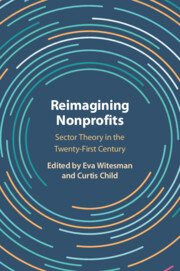Book contents
- Reimagining Nonprofits
- Reimagining Nonprofits
- Copyright page
- Contents
- Figures
- Tables
- Contributors
- Acknowledgments
- 1 An Invitation to Rethink the Nonprofit Sector
- Part I Overviews
- Part II Reflections and Refinements
- 5 Sector Theorists Should Consider How Social Values Determine Unmet Needs
- 6 Sector Theorists Should Embrace a Social Economy Perspective
- 7 Sector Theorists Should Expand Three-Failures Theory to Include the Family Sector and Varied Forms of Government
- 8 Sector Theorists Should Be Wary of the Nonprofit Industrial Complex
- 9 Sector Theorists Should Be Inclusive of Muslim and Non-Western Perspectives
- 10 Sector Theorists Should Revisit the Role of Information
- 11 Sector Theorists Should Borrow Epistemologies
- Part III New Directions
- Part IV Conclusion
- Index
- References
8 - Sector Theorists Should Be Wary of the Nonprofit Industrial Complex
from Part II - Reflections and Refinements
Published online by Cambridge University Press: 11 January 2024
- Reimagining Nonprofits
- Reimagining Nonprofits
- Copyright page
- Contents
- Figures
- Tables
- Contributors
- Acknowledgments
- 1 An Invitation to Rethink the Nonprofit Sector
- Part I Overviews
- Part II Reflections and Refinements
- 5 Sector Theorists Should Consider How Social Values Determine Unmet Needs
- 6 Sector Theorists Should Embrace a Social Economy Perspective
- 7 Sector Theorists Should Expand Three-Failures Theory to Include the Family Sector and Varied Forms of Government
- 8 Sector Theorists Should Be Wary of the Nonprofit Industrial Complex
- 9 Sector Theorists Should Be Inclusive of Muslim and Non-Western Perspectives
- 10 Sector Theorists Should Revisit the Role of Information
- 11 Sector Theorists Should Borrow Epistemologies
- Part III New Directions
- Part IV Conclusion
- Index
- References
Summary
This chapter critically considers the historic and contemporary entanglements of the nonprofit sector with the state and the market, and the implications of such entanglements on nonprofits, marginalized communities, and the possibility of social change. Interrogating what happens to the structural institutional form of the nonprofit when intertwined with the state and the economy in what some call the nonprofit industrial complex, Rojas assesses the fallout that leads to exacerbated policing and incarceration of women and communities of color, among other deleterious impacts. The work of naming these concerns and critiques is necessary for nonprofits to potentially become avenues for social transformation. The chapter concludes with practical interventions toward building organizations capable of creating more just futures.
Keywords
- Type
- Chapter
- Information
- Reimagining NonprofitsSector Theory in the Twenty-First Century, pp. 154 - 173Publisher: Cambridge University PressPrint publication year: 2024

